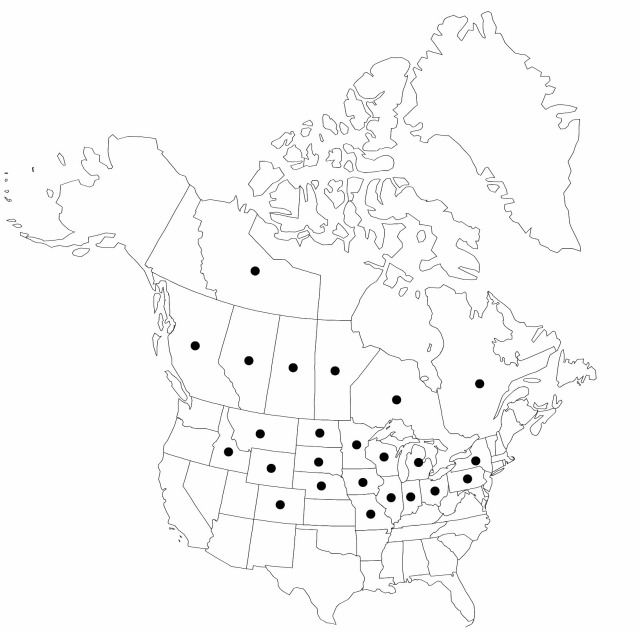Difference between revisions of "Carex sartwellii"
Amer. J. Sci. Arts 43: 90. 1842.
FNA>Volume Importer |
imported>Volume Importer |
||
| (6 intermediate revisions by 2 users not shown) | |||
| Line 8: | Line 8: | ||
}} | }} | ||
|common_names=Carex de Sartwell | |common_names=Carex de Sartwell | ||
| + | |special_status={{Treatment/ID/Special_status | ||
| + | |code=F | ||
| + | |label=Illustrated | ||
| + | }}{{Treatment/ID/Special_status | ||
| + | |code=E | ||
| + | |label=Endemic | ||
| + | }} | ||
|basionyms= | |basionyms= | ||
|synonyms= | |synonyms= | ||
| Line 24: | Line 31: | ||
|elevation=0–2100 m | |elevation=0–2100 m | ||
|distribution=Alta.;B.C.;Man.;N.W.T.;Ont.;Que.;Sask.;Colo.;Idaho;Ill.;Ind.;Iowa;Mich.;Minn.;Mo.;Mont.;Nebr.;N.Y.;N.Dak.;Ohio;Pa.;S.Dak.;Wis.;Wyo. | |distribution=Alta.;B.C.;Man.;N.W.T.;Ont.;Que.;Sask.;Colo.;Idaho;Ill.;Ind.;Iowa;Mich.;Minn.;Mo.;Mont.;Nebr.;N.Y.;N.Dak.;Ohio;Pa.;S.Dak.;Wis.;Wyo. | ||
| − | |discussion=<p>Carex sartwellii is an important wetland species in portions of the Midwest and West, but becomes increasingly uncommon and local eastward. It forms large, loose clones, but can be easily overlooked because flowering and fruiting are sometimes uncommon. Once seen, the tall, tristichous vegetative culms scattered along the rhizome are distinctive.</p> | + | |discussion=<p><i>Carex sartwellii</i> is an important wetland species in portions of the Midwest and West, but becomes increasingly uncommon and local eastward. It forms large, loose clones, but can be easily overlooked because flowering and fruiting are sometimes uncommon. Once seen, the tall, tristichous vegetative culms scattered along the rhizome are distinctive.</p> |
|tables= | |tables= | ||
|references= | |references= | ||
| Line 33: | Line 40: | ||
-->{{#Taxon: | -->{{#Taxon: | ||
name=Carex sartwellii | name=Carex sartwellii | ||
| − | |||
|authority=Dewey | |authority=Dewey | ||
|rank=species | |rank=species | ||
| Line 47: | Line 53: | ||
|publication title=Amer. J. Sci. Arts | |publication title=Amer. J. Sci. Arts | ||
|publication year=1842 | |publication year=1842 | ||
| − | |special status= | + | |special status=Illustrated;Endemic |
| − | |source xml=https:// | + | |source xml=https://bitbucket.org/aafc-mbb/fna-data-curation/src/2e0870ddd59836b60bcf96646a41e87ea5a5943a/coarse_grained_fna_xml/V23/V23_525.xml |
|genus=Carex | |genus=Carex | ||
|section=Carex sect. Holarrhenae | |section=Carex sect. Holarrhenae | ||
Latest revision as of 21:41, 5 November 2020
Culms trigonous, scabrous-angled distally, (30–)40–120 cm; vegetative culms somewhat taller. Leaves: basal sheaths brown; sheaths glabrous, inner band green, veined, apex hyaline, prolonged 1–4.5 mm; ligules 2.2–8 mm; blades 2.5–4.6 mm wide. Inflorescences nearly cylindric, except near apex, 2.5–7(–9) cm; spikes ascending, ovate, 3.2–11 × 1.1–7 mm, basal spikes slightly more prominent than middle spikes. Pistillate scales pale brown to straw colored at maturity, hyaline margins, ovate, apex acute to acuminate, glabrous. Staminate scales pale brown to straw colored, narrowly ovate, apex acute, glabrous. Perigynia (2.5–)2.8–4.1(–4.6) × 1.3–2 mm; beak 0.4–1(–1.2) mm. Achenes brown.
Phenology: Fruiting Jun–Jul.
Habitat: Fens, wet prairies, sedge meadows, marshes, wet, open thickets, open swamps, stream, pond, and lakeshores, ditches, often in shallow water
Elevation: 0–2100 m
Distribution

Alta., B.C., Man., N.W.T., Ont., Que., Sask., Colo., Idaho, Ill., Ind., Iowa, Mich., Minn., Mo., Mont., Nebr., N.Y., N.Dak., Ohio, Pa., S.Dak., Wis., Wyo.
Discussion
Carex sartwellii is an important wetland species in portions of the Midwest and West, but becomes increasingly uncommon and local eastward. It forms large, loose clones, but can be easily overlooked because flowering and fruiting are sometimes uncommon. Once seen, the tall, tristichous vegetative culms scattered along the rhizome are distinctive.
Selected References
None.
